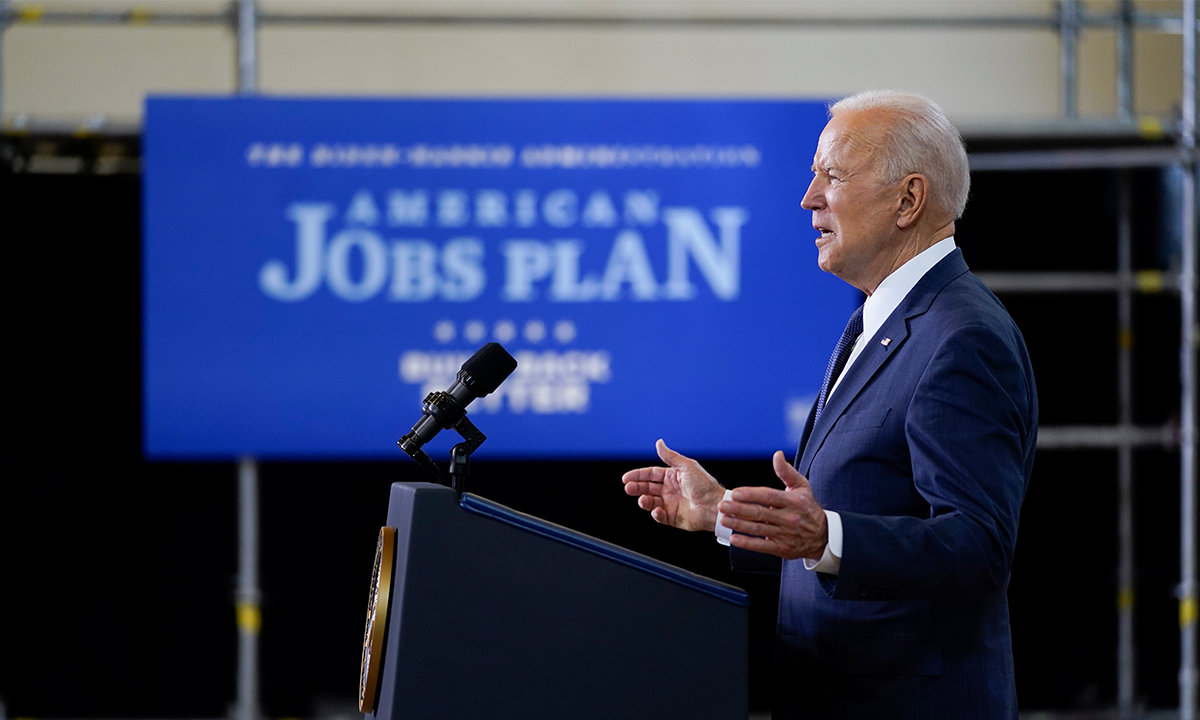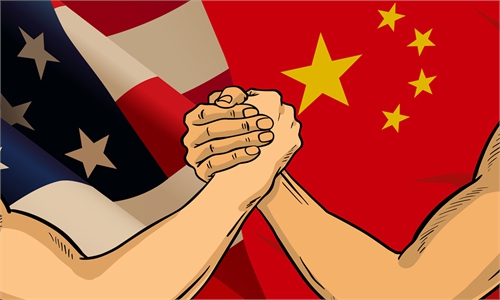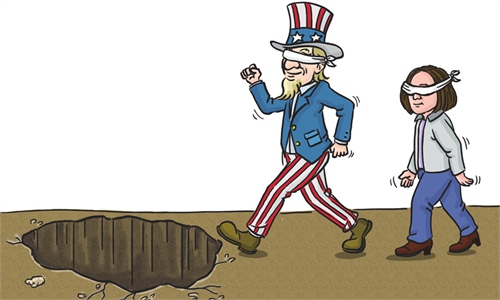
US President Joe Biden delivers a speech on a $2 trillion infrastructure spending at Carpenters Pittsburgh Training Center on Wednesday in Pittsburgh. Photo: VCG
US President Joe Biden introduced on Wednesday a $2 trillion plan over eight years in a bid to create millions of jobs in the US through infrastructure investment.
Analysts said Thursday whether the plan can be implemented remains unknown, and that the infrastructure stimulus plan is a short-term "potent medicine." They also noted that Chinese enterprises, with rich experience and strong ability, are willing to participate in the plan, but they may face barriers.
Under the "American Jobs Plan," the Biden administration plans to fix transportation infrastructure including highways, bridges, ports, airports, railways and electric vehicles; to revitalize digital infrastructure, including expansion of broadband access and upgrading of electric grids; to invest in manufacturing to secure the US supply chain, according to a statement released by the White House on Wednesday.
Former US president Barack Obama's ambitious vision for updating America's infrastructure, which he came up with shortly after taking office, failed in both two terms. His successor Donald Trump's plan also came to nothing. And now Biden has started the third round of infrastructure plans.
Visible difficulties
Wang Peng, an associate professor at the Gaoling School of Artificial Intelligence at the Renmin University of China, said that the implementation and feasibility of Biden's ambitious infrastructure plan remains uncertain.
"With the current political split in the US, it is still difficult to pass a bipartisan vote in the Congress. More political battles appear when more interests are involved, which constantly engulf original intentions," Wang told the Global Times on Thursday.
Tian Yun, vice director of the Beijing Economic Operation Association, also told the Global Times on Thursday that the current Biden proposal is more like presenting an intention or direction and there is still a big step ahead for its approval by Congress and the implementation period.
So far, the Republicans have lined up to take shots at the proposal, according to US media reports.
Even if the proposal could be implemented one day in the future, Tian doubted the effect it can achieve in bolstering the US economy and industrial development, citing its huge difficulties in attracting foreign direct investment (FDI).
"By well-built infrastructure, the US government wants to rejuvenate its manufacturing capabilities and supply chain with more participation of FDI in the process," Tian said. However, for foreign investors, it is the expectation that they can have margins that trigger their interest otherwise the plan will not make any mark there.
This can be understood from the $134 billion FDI the US has attracted in 2020, while China surpassed the US to become the largest inflow recipient with $163 billion, according to a report by the UNCTAD released in January.
"As revealed in a documentary entitled American Factory, there are many challenges for US manufacturing to come back as wished by administrations from Obama to Biden, since it has been 'dormant' for decades and become void," Tian said, adding that a lack of an efficient labor force and relevant experience are the main hurdles.
For example, Tesla set up a factory in Shanghai and then exported its cars to Europe.
"The US' development of new energy vehicles has lagged behind significantly over the past five years. The industry is shifting to Asia, especially car batteries, which are made in China, Japan and South Korea," Zhang Xiang, an analyst of the automobile industry, told the Global Times on Thursday.
"Apart from a lack of productive elements that can parallel those of China, corporate tax hikes sound horrifying for enterprises and its affluent people, and the latter is much likely to transfer their wealth overseas to cities like China's Shanghai or Hong Kong," Tian forecasted.
Analysts said that $2 trillion will be a small sum of money under such an ambitious plan for nearly 10 years, and that infrastructure construction cannot be achieved in a short period of time.
According to Tian, if Biden's proposal was finally in the implementation period, there is a high chance that it would turn into a "bottomless pit" that would way surpass the originally planned investment figure, which means taxes will go up.
Tian also pointed out that the US' large-scale construction sector could not avoid economic cooperation with major powers like China, whose raw materials and a high-quality labor force could be sourced.
Can Chinese firms join?
The infrastructure plan involves many sectors, but Chinese firms may have opportunities only in certain traditional infrastructure projects such as bridges, highways, and ports due to US' current China policy, Gao Lingyun, an expert at the Chinese Academy of Social Sciences in Beijing who closely follows China-US trade relations, told the Global Times on Thursday.
"Chinese companies' participation in the US has been influenced by the tense bilateral relationship over the past few years. They have encountered many obstacles and problems," a wind power industry practitioner who used to work as manager at Chinese wind power enterprise Guodian United Power Technology Co, told the Global Times on Thursday, on the condition of anonymity. In the past few years, both United Power and Beijing Goldwind Science & Creation Windpower Equipment Co had projects in the US.
The practitioner now works for US power giant GE to avoid crackdowns, as he doubted whether there would be any changes under the Biden Administration. He attributed Chinese enterprises leaving the US, especially power companies, to unfamiliarity with market rules, policies in flux, and a deteriorating business environment.
Apart from power, Gao added that in some high-tech sectors, such as the construction of 5G and 6G facilities, Chinese firms, even with fairly competitive strength that could save both money and time more effectively than their US counterparts, would be ruled out from the beginning.
"China of course has experience, ability and is willing to participate in the sector. However, it should be cautioned that the US may impose restrictions on some Chinese enterprises, especially state-owned ones, thus setting barriers for their participation," Gao said.
Infrastructure cooperation could be a win-win, but the US also has to provide a fair edge for Chinese firms, analysts said.
Gao cautioned that in the current state of the US, reviving its economy through the infrastructure stimulus plan is actually a short-term potent medicine, and could not solve the problem "down to the bottom."
But Wang said that this could be the most suitable plan for the US at the current stage.
"In general, the US is underinvesting and overconsuming, as can be seen from its trade deficit. Exports of high-tech goods are not enough to offset America's huge imports. Consumption has suffered greatly in the context of the epidemic, and investment is the only way to boost the economy. Macro-level infrastructure construction can be extended to guide industrial upgrading and transformation. In the big picture, the US' fiscal policy has moved from moderation to positivity, which is in perfect harmony with infrastructure spending and the stimulus package," Wang said.



